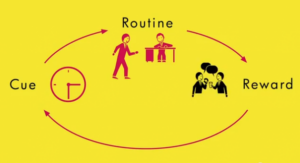It’s Your Choice: Creating Habits for Success
Charles ate a large chocolate chip cookie every day about 3:30 while chatting with co-workers in the company cafeteria.
This went on for a long time and he gained weight.
He wanted to stop. His wife was nagging him. He kept on doing it anyway.
The 3:30 cookie had become a habit he couldn’t break.
So tells Charles Duhigg on himself in his book,The Power of Habit.
Duhigg tells us how we create habits and why they are so hard to break.
Habits are choices we deliberately make, stop thinking about, and continue doing with no end in sight.
Habits are pervasive, direct our lives and we are only partially aware of their impact. In fact, more than 40% of our daily activities are driven out of habit, not actual decisions, according to a researcher at Duke University.
Habits per se are not bad. They are practical and can serve us well. Once established, we automatically perform activities without thinking, saving the kind of mental energy we expend when doing something for the first time, or a task that requires focused concentration.
Duhigg writes about a loop that starts with a Cue, leads to a Routine, and then a Reward. Think of a smoker: nicotine withdrawal (Cue), leads to smoking a cigarette (Routine) and the desire is satisfied (Reward), temporarily.
As all behavior change starts with awareness, he wanted to understand what as happening.
Duhigg came to admit to himself he was having that cookie even on days when he wasn’t hungry. So, it wasn’t about food.
To decipher the habit, he started to analyze his behavior to understand what was driving the Cue-Routine-Reward loop. Employing a methodical approach with some trial and error, he discovered he was really looking for mid-afternoon stimulation and socializing.
He felt bored (Cue), went to the lunchroom, visited with colleagues for a few minutes while eating a cookie (Routine), and returned to his desk feeling somewhat refreshed (Reward).
Acting on this insight, he substituted a new routine for the cookie in the cafeteria. When his energy dipped mid-afternoon (Cue), he stopped by a colleague’s desk for a brief chat (Routine) and he satisfied his desire for stimulation and socializing (Reward), without eating a cookie.

Why was the pattern so hard to break? It had become a powerful habit.
What cements these activities into not just patterns of behavior but sustainable, hard-to-break habits is the anticipation of the reward, which creates a kind of craving. The craving can be overt, like the desire for nicotine, or subtle like a reassuring word from a close friend when feeling stressed.
Researchers have determined that the craving for the reward can be very powerful and if the reward doesn’t come, it can result in restlessness, irritability and even depression.
This approach of intentionally and strategically creating new habits is rooted in making new choices. It has been used successfully to break personal bad habits, create winning football teams, shift corporate culture, and increase employee engagement in companies large and small.
Duhigg gives examples of these successes and reveals in greater detail how to gain insight into a current habit and develop a method for creating a new habit.
He also cautions that while the model is simple to understand and some habits are easy to change, many require patience and perseverance to create change that lasts.
Bottom line: it’s our choice.
